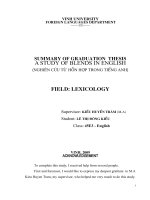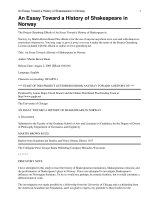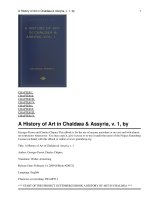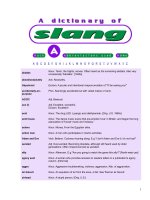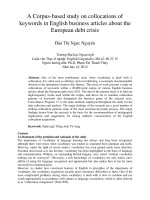Borrowed words a history of loanwords in English
Bạn đang xem bản rút gọn của tài liệu. Xem và tải ngay bản đầy đủ của tài liệu tại đây (2.2 MB, 512 trang )
Borrowed Words
Also by Philip Durkin
The Oxford Guide to Etymology
Borrowed Words
A History of Loanwords
in English
Philip Durkin
1
3
Great Clarendon Street, Oxford, OX2 6DP,
United Kingdom
Oxford University Press is a department of the University of Oxford.
It furthers the University’s objective of excellence in research, scholarship,
and education by publishing worldwide. Oxford is a registered trade mark of
Oxford University Press in the UK and in certain other countries
© Philip Durkin 2014
The moral rights of the author have been asserted
First Edition published in 2014
Impression: 1
All rights reserved. No part of this publication may be reproduced, stored in
a retrieval system, or transmitted, in any form or by any means, without the
prior permission in writing of Oxford University Press, or as expressly permitted
by law, by licence or under terms agreed with the appropriate reprographics
rights organization. Enquiries concerning reproduction outside the scope of the
above should be sent to the Rights Department, Oxford University Press, at the
address above
You must not circulate this work in any other form
and you must impose this same condition on any acquirer
Published in the United States of America by Oxford University Press
198 Madison Avenue, New York, NY 10016, United States of America
British Library Cataloguing in Publication Data
Data available
Library of Congress Control Number: 2013940283
ISBN 978–0–19–957499–5
Printed in Great Britain by
CPI Group (UK) Ltd, Croydon, CR0 4YY
Links to third party websites are provided by Oxford in good faith and
for information only. Oxford disclaims any responsibility for the materials
contained in any third party website referenced in this work.
For Kathryn
Acknowledgements
This book has arisen primarily from my work on The Oxford English
Dictionary, and draws heavily on the collaborative research of my many
very talented colleagues on the dictionary’s staff. If the OED did not exist,
this book, like very many others, would have been entirely impossible; if
I had not had the good fortune to work in such a friendly and supportive
environment, writing it would have been a much less pleasant experience.
I am greatly indebted to friends and colleagues from many corners of the
world who have commented on drafts of either the whole or parts of this
book, especially: Rhona Alcorn, Mark Chambers, Richard Dance,
Anthony Esposito, Alan Kirkness, Roger Lass, Ursula Lenker, Serge Lu-
signan, Seth Mehl, Inge Milfull, Sara Pons-Sanz, Herbert Schendl, John
Simpson, Janne Skaffari, Katrin Thier, and Edmund Weiner. Responsi-
bility for any errors of course remains entirely my own.
I have also benefitted hugely from comments on papers containing
research for this book from audiences at the Sixteenth International Con-
ference on English Historical Linguistics (ICEHL), Pécs, Hungary; the
Fifth International Conference on Historical Lexicography and Lexicology
(ICHLL), Oxford; the Seventh International Conference on Middle English
(ICOME), Lviv; the LIPP Sym posium on linguistic change, Ludwig-
Maximilians-Universität, Munich; HELLEX 3 (New Approaches in
English Historical Lexis), Helsinki; the Colloquium ‘Present and future
research in Anglo-Norman’, organized by the Anglo-Norman Dictionary
team in Aberystwyth; and seminar audiences in Cambridge, Oxford,
London (Westminster), Bamberg, Poznan´, and Warsaw. I am very grateful
to my hosts at all of these events for providing such valuable fora for working
through and debating some of the ideas in the book.
That this book looks so good in its finished form owes a great deal to
many talented colleagues at OUP, including Julia Steer, Jen Moore, Vicki
Hart, and Briony Ryles. I consider myself, and this book, particularly
fortunate to have benefitted from the generous and ex pert advice of John
Davey, who retired from OUP at Easter 2013; his editorial skills are
legendary, as is his contribution to the world of linguistics, and it is a
great privilege to have worked with him on this project and others.
Concise Contents
Full Contents ix
List of Figures xvii
List of Abbreviations xx
PART I INTRODUCTION
1 Introd ucing concepts 3
2 Introducing the data 22
PART II EARLY CONTACTS IN CONTINENTAL
EUROPE AND BRITAIN
3 Historical and cultural background to c.1150 53
4 Very early borrowings into Germanic 66
5 Old English in contact with Celtic 76
PART III OLD ENGLISH AND PROTO-OLD ENGLISH
IN CONTACT WITH LATIN
Introduction to part III 97
6 An overview of Latin loanwords in Old English 99
7 Interrogating the data from chapter 6 120
8 Methodologies: sound change; word geography;
loanwords versus semantic borrowing 143
Conclusions to part III 168
PART IV SCANDINAVIAN INFLUENCE
Introduction to part IV 171
9 Introduction to Scandinavian loanwords in English 173
10 Identifying Scandinavian borrowings and assessing
their impact 190
Conclusions to part IV 220
PART V BORROWING FROM FRENCH AND LATIN
IN MIDDLE ENGLISH
Introduction to part V 223
11 Exploring the contact situation and identifying loans 227
12 Quantifying French and Latin contributions
to Middle English 254
13 Example passages from English and multilingual texts 281
Conclusions to part V 296
PART VI LOANWORDS INTO ENGLISH AFTER 1500;
HOW BORROWING HAS AFFECTED THE LEXICON
Introduction to part VI 299
14 Borrowing from Latin and French after 1500 305
15 Loanwords from other languages: test cases 350
16 Long-term effects of loanwords on the shape of the
English Lexicon 400
17 General conclusions and pointers for further
investigation 424
References 429
General Index 455
Word Index 467
The companion website for the book is available at
www.oup.co.uk/companion/durkin2
viii concise contents
Full Contents
List of Figures xvii
List of Abbreviations xx
PART I INTRODUCTION
1 Introducing concepts 3
1.1 A first illustration of the part played by loanwords
in the vocabulary of modern English 4
1.2 Some initial definitions of terms 7
1.2.1 Periods in the history of English 7
1.2.2 Types of lexical borrowing; borrowing and code
switching; borrowing and imposition 8
1.3 Some different approaches to studying lexical
borrowing 11
1.4 On evidence and hypotheses 13
1.5 What constitutes the vocabulary of English? 15
2 Introducing the data 22
2.1 Assessing input from different languages in the
vocabulary of modern English 22
2.2 Examining loanwords in the high-frequency vocabulary
of modern English 34
2.3 Assessing the impact of borro wing on the ‘basic’
vocabulary of English 41
2.4 Some implications of this data for the shape of
this book 45
PART II EARLY CONTACTS IN CONTINENTAL
EUROPE AND BRITAIN
3 Historical and cultural background to c.1150 53
3.1 The Germani at the dawn of their recorded history 53
3.2 The Germani on the continent in later Roman times 54
3.3 Britain before the Romans 55
3.4 Roman Britain and its linguistic situation 56
3.5 From the Anglo-Saxon ‘Settlement’ to the first
Christian centuries 59
3.6 The influence of Latin after the conversion 62
3.7 Anglo-Saxons and Scandinavians 64
3.8 The Norman Conquest 65
4 Very early borrowings into Germanic 66
4.1 Language families and comparative reconstruction 66
4.2 Very early borrowings from Celtic 69
4.3 Very early borrowings from Latin 72
5 Old English in contact with Celtic 76
5.1 Lexical borrowings from Celtic into Old English 77
5.2 The evidence of personal names and place names 81
5.3 A comparison: borrowing from Celtic into French 83
5.4 The hypothesis of structural borrowing from Celtic
in English (‘the Celtic hypothesis’) 87
5.5 Epilogue: later lexical borrowing from Celtic languages 91
5.6 Conclusions 94
PART III OLD ENGLISH AND PROTO-OLD ENGLISH
IN CONTACT WITH LATIN
Introduction to part III 97
6 An overview of Latin loanwords in Old English 99
6.1 Estimating the scale of the contribution 99
6.2 Earlier and later borrowings 101
6.2.1 Identifying earlier and later borrowings 101
6.2.2 Characteristics of earlier and later borrowings 103
6.2.3 Attempts to distinguish chronological and
geographical layers of borrowing among the
early loanwords 104
6.3 The loanwords 105
6.3.1 Early borrowings (to c. AD 650) 107
6.3.2 Some cases where an early date has often been
suggested but is less certain 114
6.3.3 Some later loanwords (probably after AD 650) 116
x full contents
7 Interrogating the data from chapter 6 120
7.1 Concerns about etymologies 120
7.2 Derivatives and compounds of loanwords 121
7.3 Uncertain cases of derivation or independent
borrowing 123
7.4 Problems concerning learned borrowings 123
7.5 Assessing the influence of Latin loanwords in
Old English 129
7.5.1 Survival in modern English 129
7.5.1.1 Survivals from probable earlier borrowings 131
7.5.1.2 Survivals from later borrowings 131
7.5.2 Word frequencies and textual distribution 132
7.5.3 L oanwords showing basic meanings 137
7.5.4 A closer examination of borrowed verbs 139
8 Methodologie s: sound change; word geography;
loanwords versus semantic borrowing 143
8.1 Eviden ce based on English and Latin sound change 143
8.1.1 A selective list of chang es 144
8.1.2 Examples of Latin borrowings involving these
changes 146
8.1.3 Examples involving changes in Latin as well as
English 149
8.1.4 Changes of quantity reflected by late borrowings 154
8.1.5 How analogy can produce misleading forms:
proud and pride 154
8.2 The problem of parallels/cognates in other
Germanic languages 155
8.2.1 Greek words, the hypothesis of the ‘Danube
mission’, and some word histories that have
shown frequent reappraisals 158
8.3 Semantic borrowing 161
8.3.1 Cases where existing words acquire a new
meaning 162
8.3.2 Cases where a new word is created 164
8.4 Word-geography, borrowing, and loan rendition
reflected by the names of the days of the week in
Old English and other Germanic languages 166
Conclusions to part III 168
full contents xi
PART IV SCANDINAVIAN INFLUENCE
Introduction to part IV 171
9 Introduction to Scandinavian loanwords in English 173
9.1 Areas of Scandinavian settlement in England 173
9.2 What is meant by ‘early Scandinavian’ 175
9.3 An illustrative example of some of the main issues: they 175
9.4 Periodization 179
9.4.1 Scandinavian borrowings attested in Old English 179
9.4.2 Borrowing as reflected in Middle English and
in later sources 182
9.4.3 The likely date of borrowing and its context 187
10 Identifying Scandinavian borrowings and assessing
their impact 190
10.1 Identifying Scandinavian borrowings 190
10.2 Words distinct in sound from their native cognates 191
10.2.1 Absence of Old English /sk/ > /ʃ/ 193
10.2.2 Absence of Old English /k/ > /tʃ/ 194
10.2.3 Absence of Old English /g/ > /j/
and /gg/ > /ddʒ/ 195
10.2.4 Absence of Old English development of
Germanic *ai > a
¯
196
10.2.5 Ger manic *au >
e
¯
a in Old English (open
e
¯
in
Middle English) 197
10.2.6 *jj > gg in early Scandinavian 197
10.2.7 *ui > y in early Scandinavian 198
10.2.8 Loss of final nasals in early Scandinavian 198
10.3 Borrowings with different derivational
morphology from a cognate 198
10.4 Words with no native cognate where formal
grounds indicate borrowing 199
10.4.1 Absence of Old English /sk/ > /ʃ/ , /k/ > /tʃ/,
/g/ > /j/ 199
10.4.2 Absence of Old English development of
Germanic *ai > a
¯
200
10.4.3 Presence of early Scandinavian i-mutation
(or r-mutation) of Germanic *eu 200
10.4.4 Presence of early Scandinavian development
of æ
¯
as a
¯
200
xii full contents
10.5 Borrowings that preserve aspects of Scandinavian
morphology 201
10.6 Cases where borrowing is argued for on grounds
other than word form 201
10.7 Apparent substitution of Scandinavian sounds in
native words and vice versa 208
10.8 Words that probably show semantic influence
from Scandinavian 209
10.9 Regional distribution of Scandinavian words 211
10.10 Impact of Scandinavian borrowing on English core
vocabulary 213
10.11 The relationships of Scandinavian-derived lexis
with other English words 215
10.12 Borrowed word-forming elements and influence on
other aspects of the grammatical system 217
Conclusions to part IV 220
PART V BORROWING FROM FRENCH AND LATIN
IN MIDDLE ENGLISH
Introduction to part V 223
11 Exploring the contact situation and identifying loans 227
11.1 Sources of data 227
11.2 Multilingualism in later medieval Britain 229
11.3 Borrowing from French, Latin, and French
and/or Latin 236
11.3.1 Background 236
11.3.2 Borrowings solely from French 240
11.3.3 Borrowings solely from Latin 244
11.3.4 Borrowings from French and/or Latin 245
11.3.5 Likely mechanisms of borrowing 250
11.4 Reinforcement or re-borrowing of words borrowed
in Old English 251
12 Quantifying French and Latin contributions to
Middle English 254
12.1 Chronological breakdown 254
12.1.1 Latin, French, and Latin and/or French
borrowings in English lexicography
and lexicology 254
full contents xiii
12.1.2 Analysis of the data of the MED and OED3 255
12.1.2.1 Semantic borrowing 264
12.1.3 Studies based on particular texts or corpora 265
12.2 Anglo-French and continental French 269
12.2.1 Methodology 269
12.2.2 Distinctively Anglo-French loanwords as
documented in OED3 272
12.2.3 A test case: words identified as loanwords
from continental French in the parts of OED3
that overlap with AND2 275
12.2.4 Evidence in English lexicography for unrecorded
Anglo-French words, forms, or meanings 277
12.2.5 Some conclusions 280
13 Example passages from English and multilingual texts 281
13.1 Example passages from Middle English texts with
commentary 281
13.1.1 Passage 1: from the Final Continuation of the
Peterborough Chronicle 281
13.1.2 Passage 2: from the Ormulum 283
13.1.3 Passage 3: from the Ancrene Wisse 284
13.1.4 Passage 4: from John Trevisa’s translation of
Ranulf Higden’s Polychronicon 286
13.1.5 Passage 5: from Caxton’s Prologue to The Boke
of Eneydos 288
13.2 Some examples from multilingual texts and texts
not in English 290
Conclusions to part V 296
PART VI LOANWORDS INTO ENGLISH AFTER 1500;
HOW BORROWING HAS AFFECTED THE LEXICON
Introduction to part VI 299
14 Borrowing from Latin and French after 1500 305
14.1 The development of written English after 1500 305
14.1.1 The expanding functions of English; changes
in relationships between writing in English,
Latin, and French 306
14.1.2 Stylistic developments in the written language 307
xiv full contents
14.1.3 A re-examination of the data surveyed in
chapter 2 in light of these factors 310
14.1.4 Attitudes towards loanwords in English 316
14.2 Morphological differentiation between Latin
and French borrowings 320
14.3 Latinate spelling forms and the respelling or
remodelling of earlier borrowings 325
14.4 Affixes of Latin and French origin in English word
formation 327
14.5 Test cases: selected word families in English 332
14.6 Continued semantic borrowin g shown by earlier
loanwords 335
14.7 Increasing word frequency over time 336
14.8 Modern scie ntific formations from elements
ultimately of Latin and Greek origin 340
14.8.1 Formations in modern vernacular languages
from Latin or Greek elements 341
14.8.2 Scientific Latin 344
14.9 Neoclassical compounding in English and other
modern vernaculars 346
14.10 Summary and conclusions 347
15 Loanwords from other languages: test cases 350
15.1 Introduction 350
15.2 Loanwords from other European languages 354
15.2.1 Dutch (and Afrikaans) and Low German 354
15.2.2 High German and Yiddish 360
15.2.3 Spanish and Portuguese 364
15.2.4 Italian 369
15.2.5 Distinguishing Romance inputs in Early
Modern English 372
15.2.6 Greek 375
15.2.7 Russian 378
15.2.8 Recent loanwords from French revisited 379
15.3 Loanwords from languages from outside Europe 383
15.3.1 Arabic 383
15.3.2 Hebrew 385
15.3.3 Languages of South Asia 386
15.3.4 Malay 389
full contents xv
15.3.5 Chinese 391
15.3.6 Maori 392
15.3.7 Japanese 395
15.4 Some common themes 398
16 Long-term effects of loanwords on the shape
of the English Lexicon 400
16.1 Some key questions 400
16.2 The available research tools 401
16.3 Some test cases 405
16.3.1 Test case 1: loanwords among the 100-meaning
‘Leipzig-Jakarta List of Basic Vocabulary’ 405
16.3.2 Test case 2: the senses 411
16.3.3 Test case 3: the physical world 415
16.4 Conclusions 419
17 General conclusions and pointers for further investigation 424
References 429
General works cited by author 429
Dictionaries, reference works, and databases cited by title 452
General Index 455
Word Index 467
xvi full contents
List of Figures
2.1 Totals of loanwords from the 25 most prolific inputs in OED3. 25
2.2 The most frequent donor languages, arranged in five charts
graded by scale. 26–7
2.3 All items in OED classified by origin. (i) OED headword
entries only. (ii) All lexical items in OED.29
2.4 Loanwords from French, Latin, and French and/or Latin in parts
of OED3 so far completed, arranged chronologically. 33
2.5 New words of all origins as reflected by parts of OED3 so far
completed, arranged chronologically. 34
2.6 Loanwords from French, Latin, and French and/or Latin as a
proportion of all new words, as reflected by parts of OED3 so far
completed. 35
2.7 (Indirect) origins of 1,000 most frequent words in the BNC. 38
2.8 Totals of loanwords from Scandinavian, French, Latin, and
French and/or Latin in the 1,000 most frequent words in the
BNC, arranged chronologically. 39
2.9 Loanwords from Scandinavian, French, Latin, and French and/or
Latin in the full WOLD meaning list, arranged chronologically. 43
4.1 The major Germanic languages. 67
5.1 Loanwords from Irish, as reflected by OED3 (A–ALZ and M–RZ). 94
10.1 Divergent developments from a shared base in early Scandinavian
and in English, and convergence in Middle English as a result of
borrowing. 207
12.1 Words from French, Latin, and French and/or Latin as a
proportion of all headword entries in the MED. 255
12.2 Words from French, Latin, and French and/or Latin as a
proportion of all headword entries first recorded in the Middle
English period in the MED. 256
12.3 Words from French, Latin, and French and/or Latin as a
proportion of all headword entries first recorded in the Middle
English period in OED3. 257
12.4 Absolute numbers of new words from each source per half-
century (in OED3,A–ALZ, M–R). 258
12.5 Absolute numbers of French and Latin loanwords per
half-century, combined totals (in OED3,A–ALZ, M–R). 259
12.6 Totals of all OED3 headwords (of any origin) with first dates
in each half-century. 260
12.7 Borrowings from each source as a percentage of all new words
per half-century. 261
12.8 Borrowings from French and Latin as a percentage of all new
words per half-century, combined totals. 261
12.9 Numbers of new words from each source per half-century as
reflected in the 1,000 most frequent words in the BNC. 263
VI.1 Loanwords as a proportion of all new words. 300
VI.2 Loanwords from Latin and French, and loanwords from all
other sources, as a proportion of all new words. 301
14.1 Loanwords from French, Latin, and French and/or Latin in parts
of OED3 so far completed, arranged chronologically,
1300–present. 310
14.2 Loanwords from French, Latin, and French and/or Latin as a
proportion of all new words, as reflected by parts of OED3 so far
completed, 1300–present. 311
14.3 Printed books published per year, based on ESTC data. 313
14.4 Totals of all new words in OED3 in the alphabetical range A–ALZ. 315
14.5 Verbs formed from Latin past participial stems. 321
14.6 Cases where there is an earlier parallel ultimately from the same
Latin verb. 323
14.7 Words ending in -or probably borrowed from a Latin word
ending in -or. 324
14.8 Words ending in -ory and -ary borrowed directly from Latin. 325
14.9 The proportion of words of French and/or Latin origin among
high-frequency spellings in Helsinki Corpus data for Middle
English and Early Modern English, alongside a comparable
sample from the BNC. 338
14.10 The proportion of words of French and/or Latin origin among
high-frequency spellings in Helsinki Corpus data for 1420–1500
and 1500–70. 339
15.1 Loanwords from Dutch, Low German, and Afrikaans, as
reflected by OED3 (A–ALZ and M–RZZ). 355
15.2 Loanwords from German, as reflected by OED3
(A–ALZ and M-RZZ). 362
15.3 Loanwords from Yiddish, as reflected by OED3
(A–ALZ and M–RZZ). 364
15.4 Loanwords from Spanish, as reflected by OED3
(A–ALZ and M–RZZ). 366
15.5 Loanwords from Portuguese, as reflected by OED3
(A–ALZ and M–RZZ). 369
15.6 Loanwords from Italian, as reflected by OED3
(A–ALZ and M–RZZ). 371
xviii list of figures
15.7 Loanwords from Greek, as reflected by OED3
(A–ALZ and M–RZZ). 376
15.8 The proportion of Greek loanwords that have entered English
partly via Latin, as reflected by OED3 (A–ALZ and M–RZZ). 376
15.9 Loanwords from Russian, as reflected by OED3
(A–ALZ and M–RZZ). 378
15.10 Loanwords from Arabic, as reflected by OED3
(A–ALZ and M–RZZ), 1500–present. 384
15.11 Loanwords from Hebrew, as reflected by OED3
(A–ALZ and M–RZZ), 1500–present. 386
15.12 Loanwords from languages of South Asia, as reflected by OED3
(A–ALZ and M–RZZ). 387
15.13 Loanwords from Malay, as reflected by OED3
(A–ALZ and M–RZZ). 390
15.14 Loanwords from Chinese, as reflected by OED3
(A–ALZ and M–RZZ). 391
15.15 Loanwords from Maori, as reflected by OED3
(A–ALZ and M–RZZ). 395
15.16 Loanwords from Japanese, as reflected by OED3
(A–ALZ and M–RZZ). 398
list of figures xix
List of Abbreviations
(See References for full details.)
AFW Altfranzösisches Wörterbuch
ALD The Advanced Learner’s Dictionary of Current English (2nd edn.,
1963; see also OALD)
AND The Anglo-Norman Dictionary
BNC British National Corpus
COCA Corpus of Contemporary American English
DEAF Dictionnaire étymologique de l’ancien français
DMF Dictionnaire de moyen français
DMLBS Dictionary of Medieval Latin from British Sources
DNZE The Dictionary of New Zealand English
DOE The Dictionary of Old English
DOST A Dictionary of the Older Scottish Tongue
DSAE A Dictionary of South African English on Historical Principles
ECCO Eighteenth-Century Collections Online
EDD The English Dialect Dictionary
EEBO Early English Books Online
ESTC English Short Title Catalogue
FEW Französisches etymologisches Wörterbuch
GSL A General Service List of English Words
HTOED Historical Thesaurus of the Oxford English Dictionary
MED Middle English Dictionary
OALD The Oxford Advanced Learner’s Dictionary (see also ALD)
ODEE The Oxford Dictionary of English Etymology
OED The Oxford English Dictionary
OLD Oxford Latin Dictionary
RMLW Revised Medieval Latin Word-List
SND The Scottish National Dictionary
SOED Shorter Oxford English Dictionary
TLF Trésor de la langue française
TLL Thesaurus Linguae Latinae
TOE Thesaurus of Old English
Part I
Introduction
1
Introducing concepts
The topic of this book is how borrowed words have influenced the vocabu-
lary of English over its history. A central theme is how the histories of
individual words are intertwined firstly with linguistic history, that is to say
with larger-scale trends and developments in the history of English; and
secondly with external, non-linguistic history, that is to say with historical
events and developments, such as the arrival of the Anglo-Saxons in Britain
or the Norman Conquest.
In linguistics, the term ‘ borrowing’ describes a process in which one
language replicates a linguistic feature from another language, either wholly
or partly. The metaphorical use of the word ‘borrowing’ to describe this
process has some well-known flaws: nothing is taken away from what is
termed the donor language, and there is no assumption that the ‘borrowing’
or ‘loan’ will ever be returned. In many ways, the idea of influence would be
more appropriate. However, the term ‘borrowing’ has been firmly
entrenched in linguistics as the usual term to describe this process since
the nineteenth century, to the extent that most linguists no longer even think
of it as a metaphor. This book does not attempt to change the fundamental
terminology of the discipline, but keeps to the basic framework of
borrowing, donors, recipients, and loans.
Words have both a form and a meaning. Either component can be
borrowed. This book looks in particular at those cases where both the form
and (at least some aspect of) the meaning of a word from another language
have been borrowed into English. These are conventionally called loanwords.
(For a more detailed account of terminology, see section 1.2.2.) The category
of borrowed words is sometimes restricted to words of this type, but is often
extended to include other categories, such as loan translations. For example,
in modern English we have the words omnipotent and almighty in roughly the
same meanings. Omnipotent is a l oanword from Latin omnipote
¯
nt-, omnipote
¯
ns;
both the word f orm an d the m eaning hav e be en re plicated in English. Almighty
is probably a (very early ) loan translation o f the same Latin word, based on
analysis of its component parts omni- ‘all’ and pote
¯
ns ‘powerful, mighty’.This
book deals primarily with loanwords, but other types such as loan translations
will also be considered at various points in the historical narrative.
Chapter 1 introduces some key concepts in the study of loanwords, and
will give an overall impression of the impact of loanwords on the vocabulary
of modern English. Chapter 2 looks at the proportions of borrowings in the
lexis as a whole (as reflected by the wordlist of the Oxford English Diction-
ary), among the high-frequenc y words of contemporary English, and
among those words that realize the most basic meanings. Additionally, it
introduces some of the contact situations in the history of English that have
led to the heaviest and most significant episodes of lexical borrowing.
1.1 A first illustration of the part played by loanwords
in the vocabulary of modern English
Loanwords make up a huge proportion of the words in any large dictionary
of English. They also figure largely in the language of everyday communi-
cation and some are found even among the most basic vocabulary of
English. Exact figures and percentages are problematic for various reasons,
which are examined in the course of this chapter and in chapter 2, and which
are investigated from various different points of view throughout this book.
However, one ea sy way of illustratin g the pervasive nature of loanwords in
the vocabulary of modern English is simply to look at some passages from
different types of contemporary writing. The following five passages are
taken from (i) a book written for young children, (ii) a piece of popular
fiction, (iii) a playwright’s diary (as prepared for publication), (iv) a schol-
arly monograph by a historian, and (v) a scientific research paper. I have
underlined all loanwords (except for proper names), and all words that have
been formed within English from loanwords.
‘Charlie’, she says, ‘they look like fish fingers to me, and I would never eat a fish finger.’
‘I know that, but these are not fish fingers. These are ocean nibbles from the supermar-
ket under the sea—mermaids eat them all the time.’
(Lauren Child I will not ever never eat a tomato (2000).)
4 introducing concepts

